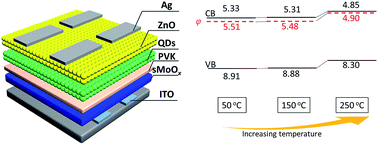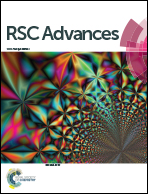Low-temperature solution-processed MoOx as hole injection layer for efficient quantum dot light-emitting diodes
Abstract
In this work, quantum dot light-emitting diodes (QD-LEDs) based on a low-temperature solution-processed MoOx hole injection layer were fabricated. As a result of the excellent wettability of the MoOx precursor, a smooth sMoOx HIL film with a roughness of less than 1 nm was obtained. In comparison with a device based on PEDOT:PSS, the best sMoOx-based QD-LED displayed comparable device performance in terms of a maximum luminance of 10 225 cd m−2, a peak current efficiency of 4.04 cd A−1, a maximum external quantum efficiency of 1.61% and, more importantly, an approximately threefold increase in operational lifetime. Furthermore, we investigated the relationship between the thermal treatment of the sMoOx film and the device performance. UPS measurements revealed that the work function of the sMoOx film underwent an upshift from 5.51 to 4.90 eV when the annealing temperature was increased from 50 to 250 °C, which indicated that low-temperature treatment of the sMoOx HIL is beneficial for hole injection and EL performance. This demonstration of a bright, efficient and stable sMoOx-based QD-LED provides another feasible application of solution-processable transition metal oxide materials as the HIL within QD-LEDs and promotes the development of low-cost, all-solution-processed optoelectronic devices.



 Please wait while we load your content...
Please wait while we load your content...